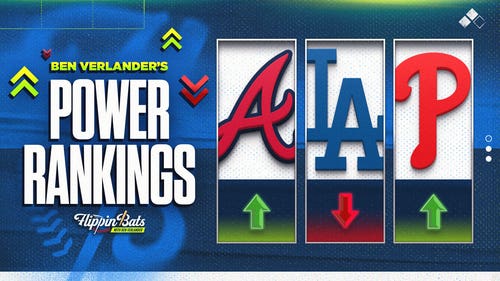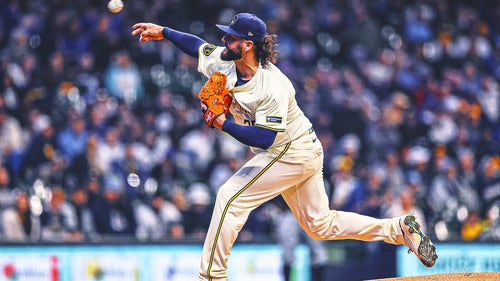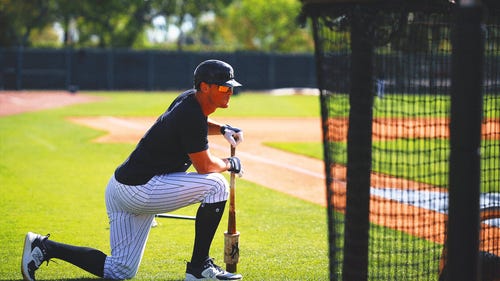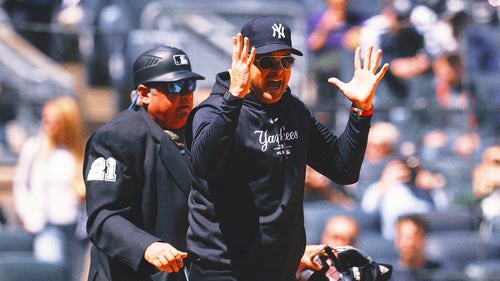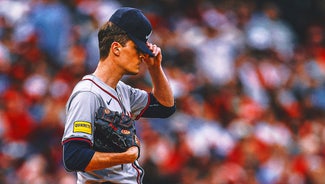
The three people who explain baseball right now
I think that the 2014-15 baseball offseason is off to a roaring start. And no, this isn'€™t about Giancarlo Stanton getting a contract that sounds more like a Powerball jackpot.
It'€™s true that major free agents like Jon Lester, James Shields, Max Scherzer and Hanley Ramirez haven'€™t signed yet, but even when they do, it won'€™t be very interesting. We know that talented players get their big paydays. But already, we'€™ve seen some moves that reveal a lot about where the game is going and it'€™s not even Thanksgiving. While everyone else is focusing on Lester and Scherzer, may I suggest that you'€™d learn much more by focusing on Hank Conger.
Hank Conger?
It'€™s not usually news when a team trades its backup catcher, so I wouldn'€™t blame you for not knowing that Conger was traded from the Angels to the Astros (for pitcher Nick Tropeano and catcher Carlos Perez). A week later, the Pirates traded lefty reliever Justin Wilson to the Yankees for their backup catcher, Francisco Cervelli. (If you were paying really close attention last year, the Tampa Bay Rays did the same thing when they traded for Reds backup catcher Ryan Hanigan.) Why all the love for backup backstops?
Let'€™s look at the Conger deal. The Astros already have an All-Star catcher in Jason Castro. Why trade a pitcher like Tropeano who, while not in line to be a world beater, has a chance to be a non-anonymous part of someone'€™s rotation for ... a backup catcher? The secret lies in Conger'€™s hidden super power. In the last few years, there'€™s been a revolution in the way that teams understand (and value) catcher defense. Particularly, we now know that some catchers are good at "€œstealing"€ extra strikes for their pitchers. This process, known as "€œpitch framing"€ seems to be the result of catchers who catch the ball "quietly"€ (i.e., without moving the glove very much.)
Most pitches are -- by design -- thrown toward the edge of the strike zone, meaning that an inch here or there can mean the difference between a called ball and a called strike. Additionally, pitches are coming in, sometimes at 90-plus miles per hour and moving all over the place. Umpires are actually pretty good at figuring out where the ball crossed the plate, but there'€™s some margin of error in there. It'€™s not a fault of the umpire. When something is going that fast, it is a bit of a blur, and the human mind automatically tends to fill in the gaps. That'€™s not a fault of the umpires. That'€™s just being human. But one of the pieces of information that an umpire might, without even thinking about it, take into account is whether the catcher'€™s glove is moving away from the strike zone. If it is, his brain is more likely to fill in the gap with the thought that the ball must have been moving that way, so it must be a ball. He might also peek at where the catcher'€™s glove ends up, and if a catcher can subtly bring a pitch back into the strike zone after catching it, he might fool the umpire.
Well, it turns out that some catchers are much better at this sort of framing than others, including Conger. Not only that, but it turns out that it makes a huge difference. Obviously, on a 3-2 count, the ability to frame a pitch might mean the difference between a walk and a strikeout, but it can be critical on even on the first pitch of an at-bat. An 0-1 count is a big advantage for a pitcher over a 1-0 count. A plate appearance is about twice as likely to end in strikeout if the first pitch is a strike rather than a ball. For a long time, baseball stats have focused on what happens when the bat makes contact with the ball. It'€™s always been known that a pitcher would rather pitch ahead than from behind, but until lately, there have been few attempts to locate skills that might allow that to happen more often. Smart teams are starting to think in terms of controlling the count as a way to control the outcome of the at-bat.
But not only that, the Astros trading for Conger also represents a rather genius approach to roster construction. A team'€™s primary catcher will likely catch 100-110 games in the course of a season, meaning the backup will have to play 50-60 games. Conger caught in 79 last season backing up Chris Iannetta and was worth 0.7 WAR, according to Baseball-Reference. But that number doesn'€™t include what he did with his framing, which according to Baseball Prospectus' advanced catcher ratings was worth in excess of 20 runs by itself over the average catcher. That means that Conger was actually somewhere around a 2.5 win player last year. Even if he sees reduced playing time, if he does roughly what he did last year, he'€™ll clear about a win and a half of value (or so) out of the backup catcher'€™s spot, a spot that most teams barely bother to think about. It'€™s not the sort of move that wins a pennant, but it'€™s another message about where baseball is going. While most people think of roster building from the top down (hence why everyone is worried about where Lester will sign), the Astros found a way to create value from the 22nd spot on the roster. Not bad.
***
Then there'€™s the Michael Cuddyer saga. Cuddyer signing with the Mets after turning down a qualifying offer from the Rockies got plenty of coverage, but it put a spotlight (back) on a rather intractable problem in baseball. Low-payroll teams have complained for ages about their free agents walking away for big money. Baseball used to handle this problem by effectively outlawing free agency (under the reserve clause), but since the 1970s when free agency became part of the game, this problem has come up over and over. How do we handle the fact that some teams just have more money than others?
Cuddyer about sums up where we are right now. The qualifying offer system was supposed to be a way for teams to "€œprove"€ that a potential free agent really was someone they absolutely adored and couldn'€™t live without. No one would shed a tear if a random utility infielder left for New York, but that'€™s not the case when a homegrown superstar leaves because his team doesn'€™t have a payroll to commit $20 million to him. The idea was that teams could prove their fealty by offering a one-year deal at a salary that was the average of the top 125 salaries in baseball (this year, a little bit north of $15 million). The player doesn'€™t have to accept (and to date, no one has accepted a qualifying offer) but if he doesn'€™t, his team at least gets something in return. Cuddyer didn'€™t seem to fit the mold. He'€™ll turn 36 just before Opening Day 2015, didn'€™t come up through the Rockies system, and while he'€™s not an awful player, he'€™s certainly no one'€™s idea of a superstar. How did he get a qualifying offer?
Here'€™s where Cuddyer exposes the holes in the system. In general, it'€™s accepted that on the free-agent market, a one-win player will get roughly $7 million dollars. Over the last three years, Cuddyer has been worth 0.6 wins, 1.8 wins, and then 1.2 wins (in only 205 plate appearances), according to Baseball-Reference. Amid concerns about Cuddyer'€™s health and whether he was simply a product of the Rocky Mountain air, you can see someone squinting really hard and seeing Cuddyer as a guy who might produce 1.5 wins over a full season. That would make him worth roughly $10 million per year. Less than the $15.3 million that the Rockies had to offer him for the offer to qualify for draft-pick compensation. Seems strange that the Rockies would offer more than Cuddyer would actually produce.
But hold on. The $7 million per win number is generally based on free-agent contracts that actually have multi-year terms attached to them. It'€™s well known that teams often sign players for more years than they should, with the understanding that the fifth year will likely be a dud, but it'€™s a way of spreading out the cost of the anticipated benefits for this year and next year. The qualifying offer, on the other hand, requires only a one-year commitment. Had Cuddyer accepted the qualifying offer from the Rockies, he probably wouldn'€™t have been a fantastic value, but the Rockies would have been on the hook for only one year. The decision may have been very different if they'€™d been required to extend him a three- or five-year deal.
We run into a problem where the price that teams are required to offer the potential free agent is based on the 125 highest salaries in the game, but almost all of those salaries come from contracts based on an entirely different set of assumptions. Consider that in 2014, 17 players made more than $21 million (and the list is littered with some awful contracts!). But the shortest term amongst all of those deals was 5 years. To take last year'€™s big free-agent catch, Robinson Cano, as an example, Cano made $24 million in 2014. Using the $7 million per win mnemonic, it suggests that the Mariners believed that Cano would be worth about three and a half wins in 2014. Of course, that'€™s silly. Cano had put up seasons of 8.1, 5.7, 8.4 and 7.6 wins prior to signing the contract (and in 2014, he put up 6.4 wins). The Mariners were likely counting on a 7 win season, but they only paid him for half of that. Why? Because the Mariners probably know that at the end of his 10-year deal, when Cano will be 40, he'€™ll also not be putting up 7 win seasons. The 10-year term is a way of shifting costs into the future. If for some reason Cano would have been OK with taking a three-year deal, he could have asked for (and would have gotten) much more than he did per annum. If everyone did that, then the average price of the top 125 players would go way up and suddenly, offering $20 million, even just on a one-year deal for Cuddyer doesn’t sound all that appetizing.
Cuddyer is something of a warning bell. If an oft-injured guy who might put up 1.5 wins is worth a qualifying offer --€" and worse, the explanation of why he deserves a qualifying offer actually makes sense --€" then there'€™s something structurally wrong with the qualifying offer system. At this point, it actually makes sense for teams to extend qualifying offers to players whom they believe will be somewhere around league average in the next year. I somehow don'€™t think that'€™s what the qualifying offer system was supposed to do. Baseball needs to go back to the drawing board on this. Maybe the easiest fix would be to require that qualifying offers are actually four or five years in length.
And we haven'€™t even covered all the problems that arise when it comes time for those qualified free agents to actually sign ...
***
The last person who explains baseball is someone who won'€™t record an at-bat in 2015. Well ... maybe. Gabe Kapler was recently hired as the Dodgers'€™ director of player development. It's interesting because most fans don'€™t know the name of their own favorite team'€™s director of player development. Maybe it was the fact that there hadn'€™t been much offseason action to date (a couple of backup catchers were traded -- boring!), but Kapler'€™s hire actually made some news. Part of it was surely the fact that the Dodgers also made another high-profile front-office signing by luring former Rays general manager Andrew Friedman to be their president of baseball operations and that Friedman was said to be putting together a front office "€œdream team."€
Regardless of whether Kapler is the right man for the job, the fact that his hiring caused any ripples at all is part of a subtle shift in the way that front offices are perceived. Earlier this year, a graduating senior in the economics department at Brown University, Lewis Pollis, wrote a thesis that has turned out to be one of the most prescient pieces of writing on baseball in a long time. In his thesis, Pollis argued that the highest-paid general managers received only a few million dollars per year in salary. The rest of the baseball operations, scouting and development staff make salaries that while not poverty wages, are much more middle class than middle infielder.
Pollis conducted his analyses at the general manager level, but found that there are significant and very large differences between general managers in their abilities to "€œwin"€ trades and to find talent on the cheap. In doing so, a top general manager could actually be worth eight figures per year to his team based on these abilities. Why aren'€™t they paid like it? A team could theoretically hire the best general manager and a team of the best scouts, player development personnel and analysts, pay them above market rate for their skills, put them in a room and come out ahead in the deal. Even if it'€™s not quite that simple, the paper made a powerful argument that the roster of people in a team'€™s front office can have value comparable to the roster of people on a team'€™s 40-man roster. And people are starting to take notice.
This offseason has also seen the hiring of Joe Maddon as the new manager of the Chicago Cubs, reportedly for $5 million per year, a sum that suggests that his new employers believe that contributions he can make are on par with an actual player (and a good one at that!). The idea of a manager making such a salary would have been unthinkable even a decade ago, but again, it shows that baseball is beginning to understand how all the parts of an organization fit together to produce success at the major-league level and how while the players are the ones doing the pitching and hitting, it doesn'€™t mean that they deserve all of the credit for a team'€™s success. And maybe teams are starting to exploit an underpriced resource.






































































































































